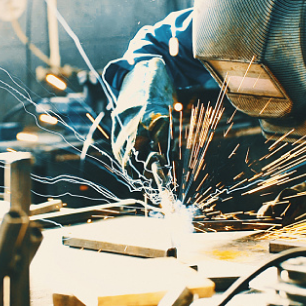Jump to:
Inspection of Coatings Applied over Welds
Welded structures are essential to the integrity of assets in sectors such as oil and gas, energy, marine infrastructure, and heavy construction. While welding quality is often under strict scrutiny, the protective coatings applied over welds frequently receive less attention, despite being equally critical in preventing corrosion and extending service life. The interaction between weld geometry, metallurgical changes, and coating performance presents unique challenges that require a dedicated inspection approach.
One of the most effective tools for addressing these challenges is the application of standards such as National Association of Corrosion Engineers (NACE) Standard SP0178, Design, Fabrication, and Surface Finish Practices for Tanks and Vessels to Be Lined for Immersion Service, which provides guidance for weld surface preparation prior to coating. (NACE is now the Association for Materials Protection and Performance [AMPP].)
Why Coating Welds Is a Unique Challenge
Unlike flat or uniform steel surfaces, weld zones exhibit distinct characteristics that can compromise coating performance if not properly treated. These include the following elements:
- Irregular geometry from weld beads and overlaps that lead to uneven coating thickness;
- Surface roughness and sharp edges, which cause thin film build-up or localized mechanical stress;
- Residual contaminants, such as spatter, slag, or oils, that reduce coating adhesion and lead to premature failure; and
- Metallurgical effects, including heat-affected zones, which may react differently to surface preparation or coating materials.
These challenges are especially critical in environments involving immersion, chemical exposure, or extreme humidity, where the coating is the first and often only barrier against aggressive corrosion mechanisms.
The Importance of Standardized Surface Preparation
NACE SP0178, originally developed for tanks and vessels intended for lining, offers industry guidance that is applicable far beyond its initial scope. The standard emphasizes the need for weld surfaces to be prepared to a quality level that aligns with the intended service conditions and coating system performance. Rather than leaving surface preparation to subjective interpretation, SP0178 promotes a consistent, engineering-based approach to determining whether a weld is ready for coating.
By defining expectations for weld appearance, cleanliness, and smoothness prior to coating application, this standard helps to close the communication gap between welding, coating, and inspection teams. When referenced in project specifications, SP0178 can serve as a benchmark to reduce ambiguity and avoid disputes over acceptability criteria, particularly in international or multicontractor projects where alignment across disciplines is crucial.
Inspection Strategies for Coated Welds
Coating inspection over welds should be treated as a specialized task, not just an extension of flat-surface procedures. It involves multiple steps:
- Visual examination of welds before coating to detect discontinuities such as undercut, porosity, or excessive convexity that could compromise coating integrity.
- Verification of surface preparation, including blast cleanliness (e.g., SSPC-SP 10 Near-White Metal Blast Cleaning/NACE NO. 2) and surface profile, to ensure proper mechanical adhesion.
- Environmental condition monitoring, including substrate temperature, ambient humidity, and dew point, to prevent flash rusting or poor curing.
- Dry film thickness measurements, which must consider the complex geometries of welds and ensure sufficient coverage in recessed or angular areas.
- Holiday testing using low- or high-voltage methods, particularly in immersion service or critical containment areas, to detect voids or discontinuities in the coating.
Each of these steps must be executed with knowledge of both welding and coatings. For instance, understanding weld symbols and joint configurations helps inspectors anticipate problem areas. Similarly, awareness of coating system limitations informs decisions about acceptable surface conditions and necessary corrective actions.
Toward Better Integration of Disciplines
The push toward multidisciplinary inspection roles is growing. Today’s inspectors are increasingly expected to be familiar with welding codes and coating standards, particularly when working on infrastructure exposed to demanding environmental conditions. Integrating knowledge from both fields is not only beneficial, it is often essential.
Using NACE SP0178 as part of the inspection workflow, for example, enhances consistency, traceability, and confidence in long-term coating performance over welded substrates. It helps engineers and inspectors ensure
that coating failures do not originate from the weld interface — a historically vulnerable and often neglected zone.
Incorporating this standard into fabrication, painting, and quality assurance processes contributes to a higher standard of corrosion protection and structural reliability — two objectives central to modern asset integrity management.
JORGE REYNA (contacto.jrsa@gmail.com) is owner of JRSA Engineering in Monterrey, Mexico. He is an AMPP Master Coatings Inspector, AMPP Senior Certified Coating Inspector, AMPP Protective Coating Specialist, ANST Level III, and AWS Senior Certified Welding Inspector.


